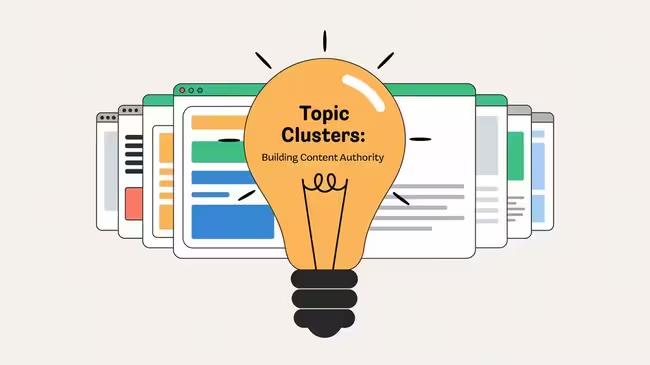Have you ever tried to organize a messy closet? Just like how grouping similar clothes together makes it easier to find what you need, topic clusters help organize your website’s content in a way that both search engines and readers love.
Let’s dive into this exciting approach to content organization that’s changing the way we think about SEO and content marketing.
Understanding Topic Clusters
Definition and Basic Concepts
Think of topic clusters like a solar system. At the center, you have your main topic (the sun), and around it orbit several related subtopics (the planets). Each piece of content is connected through careful linking, creating a web of related information that helps readers and search engines understand how everything fits together.
The Evolution of Content Organization
Remember the old days when websites would create hundreds of random blog posts hoping to rank for different keywords? That’s like throwing clothes all over your room instead of organizing them in your closet! Today’s content organization is much smarter and more strategic.
The Pillar-Cluster Model
Pillar Content Explained
Pillar content is like the foundation of a house – it’s broad, strong, and supports everything built around it. These comprehensive pages cover all the main aspects of your core topic. For example, if you’re writing about “organic gardening,” your pillar page would provide an overview of all essential aspects of organic gardening.
Supporting Cluster Content
Types of Cluster Content
Cluster content pieces are like the rooms in your house – each serves a specific purpose while being connected to the main structure. These could be:
- How-to guides
- Case studies
- Specific examples
- Detailed explanations
- Problem-solving articles
Benefits of Topic Clustering
SEO Advantages
Topic clusters are like giving search engines a clear map of your expertise. When you organize content this way, search engines can:
- Better understand your site’s authority
- See the relationships between your content
- Recognize you as an expert in your field
User Experience Benefits
For your readers, topic clusters work like a well-organized library. They can:
- Easily find related information
- Navigate naturally between connected topics
- Get a complete understanding of complex subjects
Creating Your Topic Cluster Strategy
Topic Selection
Choosing your topic clusters is like picking the right ingredients for a recipe. You need to:
- Identify your core expertise
- Understand your audience’s needs
- Find gaps in existing content
- Consider your business goals
Keyword Research
Primary Keywords
Think of primary keywords as your main chapter titles. These are the broad terms that define your pillar content. They should have:
- High search volume
- Clear relevance to your topic
- Reasonable competition levels
Related Keywords
Related keywords are like subtitles in your chapters. They help you:
- Target specific aspects of your main topic
- Capture long-tail search traffic
- Address specific user questions
Building Effective Pillar Pages
Content Structure
Your pillar page should be like a well-organized textbook:
- Clear table of contents
- Logical flow of information
- Easy navigation
- Comprehensive coverage
Length and Depth
Pillar content needs to be substantial – think of it as writing a mini-book about your topic. Aim for:
- 3,000+ words of quality content
- Comprehensive coverage
- Rich media inclusion
- Clear subheadings
Developing Cluster Content
Content Planning
Planning cluster content is like planning a family reunion – everything needs to work together! Consider:
- Content gaps to fill
- User journey stages
- Different content formats
- Publishing schedule
Internal Linking
Internal linking is like creating pathways between your content. Make sure to:
- Link cluster content to pillar pages
- Cross-reference related cluster content
- Use descriptive anchor text
- Maintain logical connection paths
Measuring Success
Key Metrics
Track your success like a teacher grades assignments:
- Organic traffic growth
- Time on page
- Bounce rates
- Conversion rates
- Search rankings
Performance Analysis
Regular analysis helps you:
- Identify successful patterns
- Find improvement opportunities
- Adjust your strategy
- Maximize your impact
Conclusion
Topic clusters aren’t just another SEO trend – they’re a fundamental shift in how we organize and present content online. By creating well-structured pillar pages and supporting cluster content, you’re not just helping search engines understand your website better; you’re providing real value to your readers.
Remember, good organization leads to better understanding, and better understanding leads to higher authority in your field.
Frequently Asked Questions
- How many cluster topics should support each pillar page?
A typical pillar page can support 8-22 cluster topics, but the exact number depends on your topic’s breadth and your audience’s needs. - How long does it take to see results from implementing topic clusters?
Like planting a garden, results take time. Expect to see meaningful improvements in search visibility and traffic within 3-6 months of consistent implementation. - Can I create topic clusters for an existing website?
Absolutely! You can reorganize existing content into clusters and create new content to fill gaps, just like reorganizing a bookshelf with both old and new books. - How often should I update my pillar content?
Plan to review and update pillar content at least every 6 months, or more frequently if your industry changes rapidly. - Do I need different pillar pages for different audience segments?
While not always necessary, creating separate pillar pages for different audience segments (like beginners vs. experts) can improve user experience and conversion rates.
